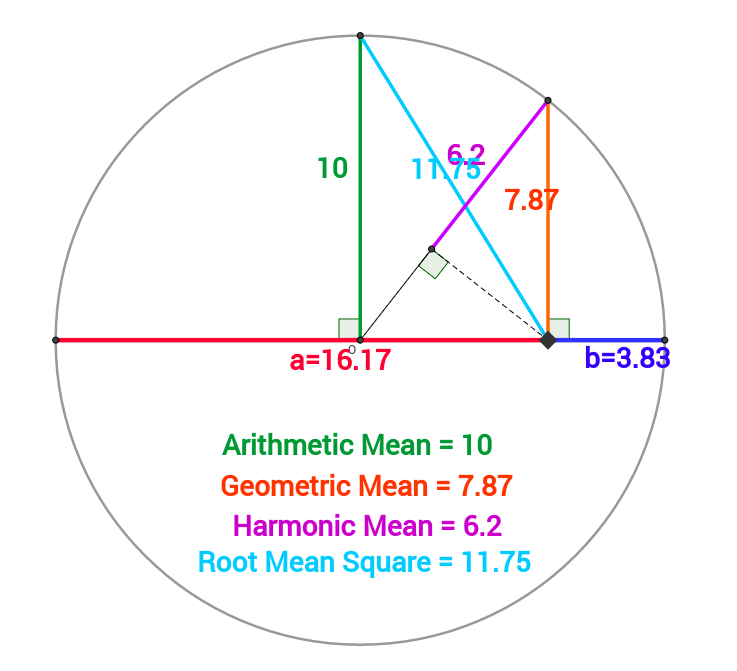Arithmetic, Geometric, and Harmonic Means
Generally, when we say “mean” value we mean the arithmetic mean. But there are two other ‘Pythagorean’ means that are commonly sean in other contexts. (For the curious, the relationship of these means is shown graphically below).
Arithmetic mean – equal to (the sum of all values)/(number of values). The Arithmetic mean will tend to be influenced most heavily by any extreme values (large or small) compared to the rest of the set. (The arithmetic mean is pulled toward the long tail of the distribution). What we almost always mean by “the mean”.
Geometric mean – The nth root of the multiplication product of all values (instead of adding all the values and dividing by the number of values, like you would for arithmetic, you multiply all the values and then take the nth root). Different from arithmetic in that it normalizes each input value to have the same weight in the final value. E.g. a change of 10% of any value in the set (regardless of whether that value is 5 or 5000) changes the mean by the same amount. Often used when numbers being input in the set have dramatically different ranges, like a bunch of ratings that are weighted 0-5, 0-100, 0-20, etc. The geometric mean (unlike the arithmetic) will reflect a % change in any of these ratings with the same change in the mean. The geometric mean is always less than the arithmetic mean unless all values are equal, in which case the two are equal.
Of note, the geometric mean of the ratios of paired data values is the same as the ratio of the geometric means of the set, making the GM the only correct mean to use when averaging normalized results. In other words, if you normalize data sets A,B, and C to one of the set’s results (say A), then compare the sets, the arithmetic and harmonic mean comparisons will change based on which set is used as the normalizer! The geometric mean comparison stays the same regardless, and the same as the original data set would have produced if not normalized. However, there is some question as to whether consistency is the same as correctness, and many sources recommend instead an a priori weighting of values in the sets if the values come from different sources (i.e. different program execution times) as opposed to measurements from the same set.
Otherwise, the geometric mean is used for things like proportional growth, exponential growth, etc.
Harmonic Mean – AKA subcontrary mean. Used most frequently for rates (like speed). The harmonic mean is the reciprocal of the arithmetic mean of the reciprocals (take 1/x for all x, summ all the values, divide the result by the number of values, then take the reciprocal of this final result). Always the least of the three Pythagorean means, and is dominated by smaller elements.
